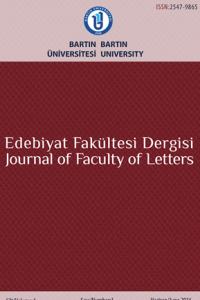KİVİ (Actinidia deliciosa) YETİŞTİRİCİLİĞİ VE TÜRKİYE ZİRAİ HAYATINDAKİ YERİ
Kültüre en son alınan meyvelerden olan kivi, kısa denilebilecek mazisinde çok hızlı bir gelişim göstermiştir.
Anahtar Kelimeler:
Kivi, Actinidia deliciosa, Hayward, kivi ziraatı, Ziraat Coğrafyası, Türkiye
KIWIFRUIT (Actinidia deliciosa) CULTIVATION AND ITS PLACE OF AGRICULTURAL LIFE IN TURKEY
Kiwifruit, one of the last fruits of the culture, has shown a very rapid development in its short history.
Keywords:
Kiwifruit, Actinidia deliciosa, Hayward, Kiwifruit Cultivation, Agricultural Geography, Turkey,
___
- ALP, Tuğba, (2017). “Kivi”, Ordu Ticaret Borsası Yayını, s. 25, Ordu.Anonim, (2006). “Kivi Yetiştiriciliği”, Hasad Yayıncılık, I. Baskı, s. 77, İstanbul.Anonim, (2013). “Kivi Üretimi Araştırma Raporu”, Ünye Ticaret Borsası, s. 22, Ünye.Anonim, (2016). “New Zealand Kiwifruit Book”, A resource for New Zealand secondary schoolteachers and growers new to the kiwifruit industry, pp. 93, New Zealand.Anonim, (2018). “Tohumluk Tescil ve Sertifikasyon Merkez Müdürlüğü 2017 Yılı FaaliyetRaporu”, TTSM Yayın Kurulu, s. 45, Ankara.ÇAVUŞ, Ahmet, (2016). “Rize İlinde Kivi Üretiminin Coğrafi Esasları”, Atatürk ÜniversitesiSosyal Bilimler Enstitüsü Dergisi, Cilt: 20, Sayı: 1, s. 225-241, Erzurum.DEBERSAQUES, Filip ve MEKERS, Omer, (2010). “Growth and Production of Kiwifruit andKiwiberry”, Soils, Plant Growth and Crop Production, Vol. II., pp. 8.DEMİR, Alkan ve EGE, Hüsnü, (2003). “Kivi”, Tarımsal Ekonomi Araştırma Enstitüsü – Bakış,Sayı: 2, Nüsha: 10, s. 4, Ankara.DOĞANAY, Hayati, COŞKUN, O., (2012). “Tarım Coğrafyası”, Pegem Akademi Yayınları,Ankara.DRUMMOND, Lynley, (2013). “The Composition and Nutritional Value of Kiwifruit”, Advancesin Food and Nutrition Research, Vol. 68, pp. 33 – 57.FERGUSON, A. Ross, (2013). “Kiwifruit: The Wild and the Cultivated Plants”, Advances in Foodand Nutrition Research, Vol. 68, pp. 15 – 32.FERGUSON, A. Ross, (2016). “Botanical Description”, Compendium of Plant Genomes, TheKiwifruit Genome, (Ed. Raffaele Testolin, Hong-Wen Huang, Allan Ross Ferguson), SpringerInternational Publishing, pp. 1 – 13, Switzerland.Food and Agriculture Organisation of the United Nations (FAO), FAOSTAT statistics.http://faostat.fao.org/site/567/default.aspx#ancor (Son erişim: 11.05.2019).GUROO, I., WANI, SA., WANI, SM., AHMAD, M., MIR, SA., MASOODI, F.A., (2017). “AReview of Production and Processing of Kiwifruit”, Journal of Food Processing & Technology, Vol. 8,Issue: 10, pp. 1 – 6.GÜLERYÜZ, M., ASLANTAŞ, R., (1993). “Dünya Kiwi (Actinidia deliciosa) Üretimi veÜlkemizde Yetişme İmkanları”, Atatürk Üniversitesi Ziraat Fakültesi Dergisi, Cilt: 24, Sayı: 2,Erzurum.HUANG, Hongwen, (2016). “Genetic Resources”, Compendium of Plant Genomes, The KiwifruitGenome, (Ed. Raffaele Testolin, Hong-Wen Huang, Allan Ross Ferguson), Springer InternationalPublishing, pp. 15 – 36, Switzerland.ITC, (2019). “Trade statistics for international business development – Kiwi Trade”,https://www.trademap.org/Index.aspx (Son erişim: 11.05.2019).KARADENİZ, Turan, (2004). “Türkiye Kivi Üretim Durumu”, Alatarım, Cilt: 3, Sayı: 1, s. 23 –27, Mersin.KODAY, Saliha, (2000). “Türkiye de Kivi Üretimi”, Doğu Coğrafya Dergisi, Cilt: 6, Sayı: 3, s.103 – 122, Erzurum.MAUGHAN, Tiffany ve BLACK, Brent, (2015). “Hardy Kiwi in the Garden”, Vegetables, Fruits,and Herbs Book, Utah State University Press, pp. 95 – 98, USA.MGM, (2019). “Meteoroloji Genel Müdürlüğü, İllerimize Ait Genel İstatistiki Veriler”,https://www.mgm.gov.tr/ (Son erişim: 11.05.2019).SIRAY, Erdal ve KILIÇ, Osman, (2016). “Türkiye’de Kivi Üretici Birliklerinin Mevcut Durumu,Sorunları ve Çözüm Önerileri”, Türkiye Tarımsal Araştırmalar Dergisi, Cilt: 3, Sayı: 1, s. 74 – 78, Siirt.TAŞLIGİL, Nuran, (2010). “Türkiye Ziraatının Problemleri”, Çantay Kitabevi, İstanbul.WARD, Carol ve COURTNEY, David, (2013). “Kiwifruit: Taking Its Place in the Global FruitBowl”, Advances in Food and Nutrition Research, Vol. 68, pp. 1 – 14.VİSSERS, Margreet C.M., CARR, Anitra C., PULLAR, Juliet M. ve BOZONET, Stephanie M.,(2013). “The Bioavailability of Vitamin C from Kiwifruit”, Advances in Food and Nutrition Research,Vol. 68, pp. 125 – 147.
- ISSN: 2602-3520
- Yayın Aralığı: Yılda 2 Sayı
- Başlangıç: 2016
- Yayıncı: Bartın Üniversitesi
